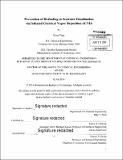Prevention of biofouling in seawater desalination via initiated chemical vapor deposition (iCVD)
Author(s)
Yang, Rong, Ph. D. Massachusetts Institute of Technology
DownloadFull printable version (22.94Mb)
Other Contributors
Massachusetts Institute of Technology. Department of Chemical Engineering.
Advisor
Karen K. Gleason.
Terms of use
Metadata
Show full item recordAbstract
Biofouling, the undesirable settlement and growth of organisms, occurs immediately when a clean surface is immersed in natural seawater. It is a universal problem and the bottleneck for seawater desalination, which reduces both the yield and the quality of desalted water. Mitigation of fouling in a desalination operation is an on-going challenge due to the delicate nature of desalination membranes, the vast diversity of fouling organisms, and the additional cross-membrane transport resistance exerted by an extra layer of coating. This thesis focuses on benign interface engineering methods and ultra-thin zwitterionic coating synthesis to bridge this gap in surface modification strategies. The direct application of ultra-thin coatings on commercial membranes with intact membrane performance has been enabled by a room-temperature vapor treatment called initiated chemical vapor deposition (iCVD). Diffusion-limited reaction conditions have shown to significantly improve the surface concentration of the antifouling zwitterionic moieties, which is crucial to the fouling resistance of modified membranes. Robustness of the ultra-thin coating is enhanced through cross-linking and covalent attachment between the membrane and the film. The resulting durability of the antifouling coating and its resistance to oxidative reagents lead to an unprecedented synergistic effect that is critical to longterm fouling resistance, which provides unique insight into the adhesion of microbial foulant and promises to lower the price of freshwater in water-scarce countries, where desalination may serve as the only viable means to provide the water supply necessary to sustain agriculture, support personal consumption, and promote economic development.
Description
Thesis: Ph. D., Massachusetts Institute of Technology, Department of Chemical Engineering, 2014. Cataloged from PDF version of thesis. Includes bibliographical references.
Date issued
2014Department
Massachusetts Institute of Technology. Department of Chemical EngineeringPublisher
Massachusetts Institute of Technology
Keywords
Chemical Engineering.